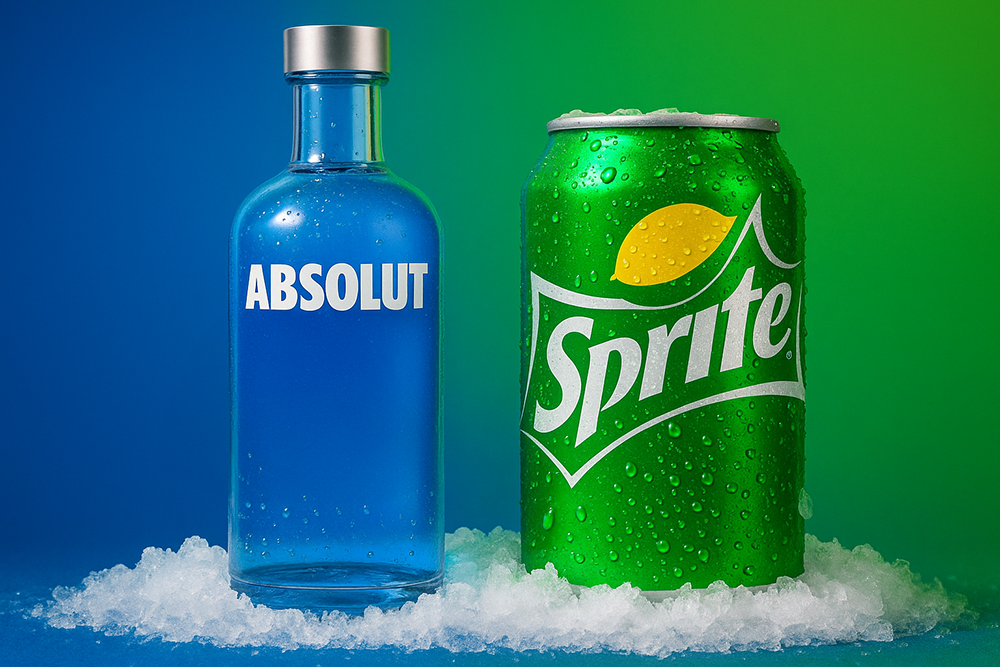Absolut Vodka and Sprite have launched a ready-to-drink 5% ABV canned cocktail in Singapore, targeting spontaneous social moments. Positioned as a premium yet effortless choice for unplanned gatherings, the collaboration signals a cultural shift toward convenience-driven, emotionally intuitive alcohol consumption in Asia’s fast-paced urban lifestyle economy.

When Absolut Vodka and Sprite were launched collectively on a can in Singapore, it was not launched as another beverage on a convenience shelf, but as a social trigger. A lifestyle catalyst designed for the spontaneous. A lightning-fast response to the micro-moments now governing urban social culture—those incidental, unscripted, temporary but richly emotional get-togethers that take place not from time to time, but as punctuations in an already frenetic life. To an outsider, it is “just another ready-to-drink product”. To those within the game—the marketers, trend spotters, beverage titans battling cultural coolness rather than market share—it is a calculated gesture that indicates where global soft drink branding, Asian nightlife dynamo and convenience culture’s next chapter are headed. Absolut & Sprite, the marriage of a classic cocktail “bar call” in a can, is less product than sign.
Singapore is where it’s at. That is not a nice brand line—it is a fundamental structural observation informing international category strategy. If there is one place in Southeast Asia where lifestyle innovation is fueled not by economic desire or cultural nostalgia but by precision, immediacy, and frictionless social logistics, it is Singapore. A rooftop party is not an idea; it is an impulse. A 7-Eleven in Singapore is not a store; it is an entrance to a lifestyle. And a 250 ml can of Sprite and vodka with 5 % ABV is not “a drink”; it is a permission note. It is Coca-Cola and Pernod Ricard standing at a high-mobility, low-friction urban social economy and saying: we are not just coming into the market—we are coming into the moment.
The product is centered on what Coca-Cola’s Ogsimer refers to as the “planned for the unplanned”. It is a behavioural read, and not a demographic one. The target consumer is not 25-to-34 urban professionals, or Gen Z, or premium nightlife spenders—it is anyone who has realized that the moment can sometimes be more important than the occasion. And the two brands behind them—Coca-Cola, which owns Sprite, and Pernod Ricard, which owns Absolut Vodka—have gone from the cultural reasoning of campaigns to the behavioural reasoning of instant accessibility. Absolut is one of the world’s leading premium vodka equities. Sprite is one of the world’s most recognizable signals of spontaneous refreshment. Together, they are counting on chemistry—not flavour chemistry, but cultural chemistry. The concept is not new, but to legitimize what people already do. In Asia’s bars, Absolut & Sprite already is an unconscious order. The innovation isn’t in the idea—it’s in the packaging, in the permission to break down the ritual.
Singapore is the macro-lab for the experiment. Distribution started not in nightclubs or high-end grocers but stealthily in 7-Eleven convenience stores—urban hotspots of urgency, not recreation. The RTD booze boom is erupting globally, but Singapore is proportionally tilted toward intent-convenience. A beverage can’t just be bought; it has to be activated situationally. It has to deliver. Worldwide, Coca-Cola crafted its adult beverage strategy with pinpoint accuracy, only entering alcohol RTD in 2023 with international partners, with rollouts in the UK, Germany and some European markets. But in Asia—particularly Singapore—category logic is reversed. In this market, RTDs aren’t a stepping stone towards alcohol maturity; they are refined micro-luxuries designed for mobility. The Absolut & Sprite can is thus a refined thesis on how to eliminate friction from premium decisions. It is not democratization of luxury—it is access personalization. It does not attempt to elevate the casual—it attempts to dramatise the casual.
Responsible marketing gets much more sophisticated at this level. Coca-Cola’s worldwide marketing integrity program prescribes strict guidelines—no children, no glamorisation of overindulgence, total adherence to local mores. That makes this introduction strategic choreography and not splashy spectacle. In Singapore, messaging is rooted not in nightlife or drunkenness, but camaraderie. Not rebellion, but freedom. The visual in initial campaign teasers tips towards sincerity over aspiration—friend groupings, slow-motion grin, city-rooftop dusk hues, not partying but exhaling. In contrast to Western alcohol campaigns that dance with anarchy or the climax, Absolut & Sprite in Singapore is constructed around the instant before the crescendo. The instant of promise over declaration. A brand simply designed for contemporary social convenience.
In its essence, this partnership is an act of balancing—neither half-and-half brand blending, but calculated brand role-play. Sprite brings accessibility and refreshment signals. Absolut brings credibility and sophistication. They both should not weaken each other. The can brand eschews boisterous party coding—it embraces familiarity and restraint instead. The goal is not to resemble an entry pass to a club, but to be a frictionless companion to social flow, whether social flow is taking place on a rooftop, at a picnic, in a hotel room pre-game, or—in the micro-entertainment culture that has emerged post-pandemic, where anything can become an occasion if energy and proximity combine. This is not a category expansion. It is a category reframing. The beverage is not attempting to be something you intend for—but something you rely upon when you don’t.
The strategic ideation here also looks ahead to the cultural shift surrounding agency in social engagement. Drinking no longer communicates celebration so much as it communicates belonging. Consumers—particularly in Singapore—are looking for indulgence that is emotionally secure, socially modular and interaction-efficient. In that way, Absolut & Sprite is a quiet concession—what used to be nightlife now is ambient life. What used to be after-work de-stress may now occur on the ride, or during an inter-episode pause, or during an 11 pm patio chat that was never scheduled but feels more authentic than choreographed brunches. Convenience is not just about being there—it is about emotional salience in microtime.
The wider signals within cannot be dismissed. The RTD boom is not a trend, but a re-architecture of how people desire to access flavour, intoxication and communality. Global brands are no longer fighting it out just on spend, but on speed, subtlety and calibration. This release is also an indicator that the future of luxury drinks is going to be fueled not by ritual locations such as restaurants or bars, but by liminal locations—transit, doorstep, balcony, after-thought-turned-moment. It is also an indicator that shoppers have moved past the premium vs casual binary—they now desire premium that acts casual. The cultural influence resides in effortless elevation.
The question for now—the only real question—is scalability. If Singapore rallies strongly, anticipate quick rollouts in markets that are similarly behaviourally advanced: Hong Kong, Seoul, Sydney, Dubai, perhaps even some Indian metros such as Bengaluru or Mumbai, where nascent social consumption intersects with high convenience-market density. But it’s not a spray-and-pray launch. Far from it. If anything, a precise cautionary placement—a social algorithm roll-out rather than an expansion of retail. If the moment succeeds, the market does too. Not the reverse.
To appreciate its potential influence, look at the consumer psychology that this product addresses. It is a person who resists performance but accepts immediacy. A person who might turn down nightclub ritual but accept 2 am rooftop discussions. A person who appreciates premium taste but hates friction. A person who refuses to say “let’s go out” but is perpetually willing to say “let’s just”. The Absolut & Sprite can is constructed around that “let’s just” moment. The unarticulated, spontaneous, emotionally acute moment that now better describes postmodern friendship dynamics than planned events.
Therefore, it is more of a cultural tool than beverage. A behavioral release. A social lubricant in the lowest, most contemporary understanding of the term. Coca-Cola and Pernod Ricard both realize that the future of beverage dominance is not in the ownership of the table—but in the ownership of the impulse that creates it. And so this is more a precision tool than a mass product. A tool which could not have been released 10 years ago, because nightlife was still centrally planned. A product that couldn’t have come out pre-pandemic, because social behaviors still weren’t on the level of individuals but of environments. But now? Now, this fits.
Why this pivot is particularly strategic is not only its brand equity or formulation but timing. Throughout Asia, the concept of “big night out” is on the decline in cultural relevance. Micro-escapes, controlled inebriation, small-circle closeness, low-prep sociability—these are the formats scaling now. That is, the beverage market is no longer competing on occasion but on entry friction. The question is no longer “what bottle do you bring to the party?” but “what moment can you instantly elevate?” In that battle, Absolut & Sprite is a weapon. Neat. Portable. Emotionally tuned. Socially shareable. And importantly—self-explanatory.
The cognitive gap is zero. Which is why the partnership comes to seem almost unavoidable in retrospect. Sprite owns global refresh equity. Absolut owns global cocktail equity. The union is not creative, it is common sense. What is creative is the execution: understated branding, simplicity of use case, clever patience with marketing ferocity. There is no effort put into making this appear revolutionary. Serene confidence is the look. The campaign is set to journey not over culture, but through it. Whether successful or not, the Absolut & Sprite launch in Singapore is already a key cultural barometer. It proves that the largest wars of consumer categories are no longer waged on scale alone but on emotional intelligence. It proves that format trumps flavour in future adoption curves.
And it verifies that international beverage giants no longer wait for moments to justify innovation; they develop products justifying moments. When a beverage is not commemorative, but catalytic—its cultural footprint is unavoidable. And maybe that’s the actual story here. Not the flavor. Not the can. Not even the two megabrands occupying space. But the reality that this product is designed for that moment that doesn’t require a reason. And culture, particularly urban Asian culture in 2025, is more composed of those moments. If Absolut & Sprite works, it won’t be because it was celebrated with a fanfare—but because it was silently, instinctively selected.In that silence lies the future of the RTD movement. A future that starts, fittingly, with something as mundane as “let’s just.”
Discover more from Creative Brands
Subscribe to get the latest posts sent to your email.





